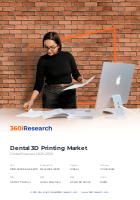
Dental 3D Printing Market by Component (3D Printers, Services, Software), Material Form (Filaments, Powders, Resins), Technology, Application, End Users - Global Forecast 2025-2030
SKU
MRR-5A2C6AA66290
Region
Global
Publication Date
December 2025
Delivery
Immediate
2024
USD 3.77 billion
2025
USD 4.34 billion
2030
USD 8.90 billion
CAGR
15.35%

Download a Free PDF
Get a sneak peek into the valuable insights and in-depth analysis featured in our comprehensive dental 3d printing market report. Download now to stay ahead in the industry! Need more tailored information? Ketan is here to help you find exactly what you need.



